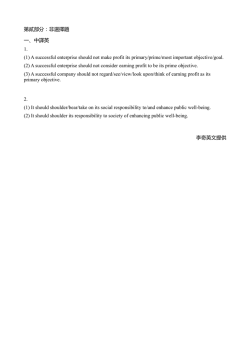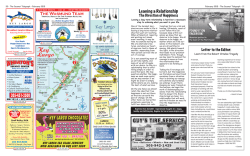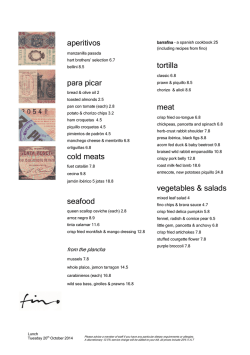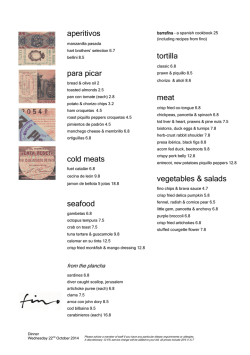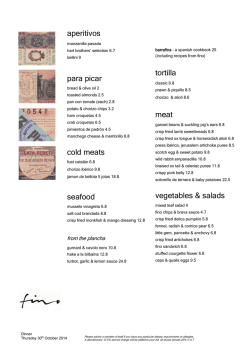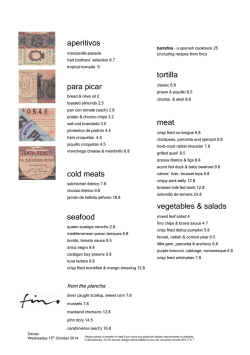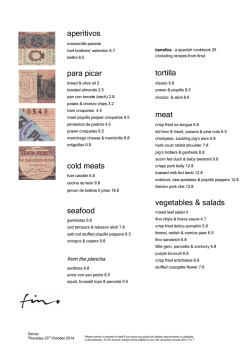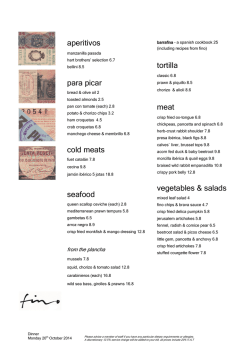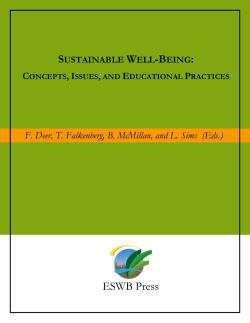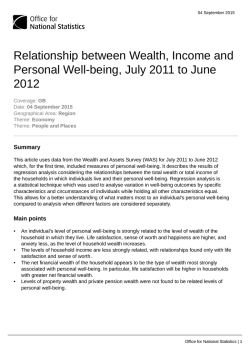
Marc Has... - ResearchGate
DESIGN VISION — CRISP Magazine #4 marc Hazzenzahl, professor of experience and Interaction at the Folkwang university of Arts in essen is an internationally acknowledged thought-leader on the topic of experience Design. His book ‘experience Design — Technology for all the right reasons’ was one of the first to provide insights in how technology can contribute to user well-being. CrIsP MagazIne #4 28 Let’s Design people happy Marc Hassenzahl “There is no way of avoiding designing for happiness,” says Marc Hassenzahl. “Happiness is a consequence of engaging in meaningful activities. Since most activities are mediated by things, design plays an inevitable and crucial role in shaping those activities. The difference lies in whether this is done with or without well-being in mind.” Designers have always been busy reinventing the world. While beloved and ridiculed visionaries of last century’s modernism, such as Buckminster Fuller, focused on better houses, better transportation, better food, efficiency and practicality, we now focus on the social and emotional life of people — their psychological well-being. We yearn to make people happy through design. Nevertheless, we have to be aware that while there once was a time when most techno-utopian suggestions were enthusiastically received, today’s post-modernistic stance is less forgiving. There is ambivalence, there is scepticism, and there is a plurality of lifestyles to be catered for. The time of the “master narratives” has passed and postmodernism has left us a little confused and dazed, because now “anything goes” and all seems highly individual and relative. Under these circumstances, can we and should we, deliberately design for happiness? Or is it just a delusion of grandeur, a disquieting and outdated attempt to create a new master narrative? Isn’t the best we can hope for to go on solving the more practical problems of life through sliced bread, machined coffee, and advanced driver assistance? Why not just let people appropriate the things we make for them in the way they prefer? They surely will find ways to increase their (un)happiness. All these questions imply choice. A choice which we unfortunately are not privileged to have. The philosophy of technology is clear about the pronounced role that “things” play in human development. We are homo faber. We make use of the material world not only to survive, but also to carry out our own projects of self-realisation (Lee, 2009). In Shaping Things, Bruce Sterling (2005) made the point that even the accomplishment of breaking rocks and using fire is not human at all; it is prehuman. These were skills we inherited from a previous species, and turned out to be necessary preconditions to become humans. Goal-directed behaviour mediated through artefacts is our very mode of being: we have hands, brains, and goals. This makes the story of designing for happiness a simple one (e.g. Hassenzahl et al., 2013). Happiness is, among other aspects, a consequence of the activities — or better practices — we engage in. And each practice is inevitably shaped by the artefacts it involves. Take driving a car as an example. Driving elicits the experience of control, competence, a feeling of “oneness” with the car, all of which can be a real pleasure. A little bit of driving can add at least a tiny bit of „ 29 transient happiness to our lives. Obviously, everybody tends to assume that the car itself plays an important role. The car is a crucial creator and mediator of the experience through its very existence and its particular design. Add, for example, driver assistance, such as adaptive cruise control, where the car does a little bit of the driving on its own, and the experience changes profoundly (Eckoldt, Knobel, Hassenzahl, & Schumann, 2012). The “oneness” is lost, suddenly the driver assumes the role of a passenger, and being driven is void of competence feelings. Whatever laudable practical goal was behind adaptive cruise control, switching it on inevitably destroys a potential for well-being. Of course, it opens up other ways to feel good, through contemplation and deep relaxation, good conversations or the option to enjoy scenic views. But the point here is that we cannot ‘not’ experience. Focusing on solving practical problems — what Evgeny Morozov (2013) calls, derogatorily, “solutionism” — does not free us from considering the potential impact this solution has on experience and well-being. To believe that Google’s self-driving car, which obviously “solves” the “problem” of driving, is meaningful without sensibly addressing the questions of what to do instead of driving would be naïve. Google certainly has a plan, a plan which somehow will include us spending more time with their products. That’s why we have no choice between designing for happiness or down-to earth practical problems. We can only choose between accepting the responsibility for creating meaningful experiences or not. I believe we should do so. If we accept the responsibility for designing for well-being, at least for the moment, let’s talk about the how. Martin Seligman, a prominent figure of the science of well-being, developed a series of interventions to “build happiness” (Seligman, Steen, Park, & Peterson, 2005). One example is the “gratitude visit”. Think of a person who has done something for you, but has never been properly thanked. Write a short testimonial, call up this person and make an appointment, without telling him or her what it is all about. During the meeting, you read the testimonial out loud. “Everyone weeps when this happens,” says Seligman in his 2004 TED talk. He tested it with 80 people and found that this intervention “produced” a month-long increase in happiness (compared to a placebo-controlled group of people). Crisp Magazine #4 30 While I admire the rigor of Seligman and colleagues’ work, I find the gratitude visit crude. Let me venture into a bit of a design critique. Obviously, the visit is a designed activity, creating a positive experience with a significant and lasting effect on well-being. But I can hardly picture myself doing it. It reeks too much of “inspirational quotes”, “self-help”, religious mash-up. Will I ever find time to do this? Then, I start to worry about how my “target” may respond and feel. Will he remember what he has done for me? Did he help me on purpose or was it unplanned, leaving him with the guilty feeling of being thanked for something for no real reason? In fact, Seligman never measured the depression scores of the people to whom the gratitude was expressed; this may have skyrocketed after the visit. Now, I am starting to picture “happy heads” aggressively pursuing their well-being by gate crashing people they barely know, just to get high on their monthly fix of gratitude. Plenty can go wrong. Experie not an It is the outcome interact the w perience is n extra. he major me of any tion with world I have no ready-made idea to counteract this. But central to our approach in the Experience and Interaction Studio at the Folkwang University of Arts is the creation of well-being, not through extra activities, but through fine-tuning existing practices. It’s the mundane that should be rejuvenated with more happiness. Coffee making, TV watching, a family dinner, the daily commute — any everyday practice can be understood as a possibility to feel closer to your loved ones, to feel competent, autonomous, stimulated, popular, secure, and healthy. Artefacts can be put in place to subtly shape activities and experiences. In fact, the careful consideration of the experiential consequences of designed things, how they might impact activities, reshape experiences, create or destroy meaning and happiness, must become a standard — no matter whether you consider yourself a “happiness designer” or not. Experience is not an extra. It can’t just be turned off. It is the major outcome of any interaction with the world. References . Eckoldt, K., Knobel, M., Hassenzahl, M., & Schumann, J. (2012). An experiential perspective on advanced driver assistance systems. It Information Technology, 54(4), 165–171. . Hassenzahl, M., Eckoldt, K., Diefenbach, S., Laschke, M., Lenz, E., & Kim, J. (2013). Designing moments of meaning and pleasure. Experience Design and happiness. International Journal of Design, 7(3), 21–31. . Lee, K. (2009). Homo Faber: the unity of the history and philosophy of technology. In J. K. B. O. Friis, E. Selinger, & S. Riis (Eds.), New waves in philosophy of technology (pp. 13–39). Palgrave Macmillan. . Morozov, E. (2013). To Save Everything, Click Here: The Folly of Technological Solutionism. PublicAffairs. . Seligman, M. E. P., Steen, T. A., Park, N., & Peterson, C. (2005). Positive psychology progress: empirical validation of interventions. The American Psychologist, 60(5), 410–21. . Sterling, B. (2005). Shaping Things. MIT Press. 21 The crucial role of context-awareness when designing for well-being Marc Hassenzahl points out that designers need to carefully consider the right time, place, and way for their interventions to have the desired effect on well-being. Evelien van de Garde and Dirk Snelders discuss this in more detail in their article on the context of PSSs. Modern technology and modern design is more akin to applied science than to a craft. Computer technology is a form of wizardry, unthinkable without modern science. This will not change when we start to design for well-being. However, the referent sciences change: psychological and sociological perspectives will become even more important. However, while these theories, methods, and insights are certainly of high quality, the interventions proposed by these disciplines — if proposed at all — lack subtlety. It is one thing to know that expressing gratitude now and then increases well-being, but quite another to find the right time, place, and way to express gratitude. To answer the latter is the strength of design. It requires a deep understanding of meaningful situations, empathy, and attention to detail. I believe that while psychology is crucial to understand well-being, designers’ skills are needed to put this understanding into action. To be successful, though, requires an emphasis on the intangible, conceptual aspects of artefacts. Of course, there is material, there is style, there is form, there is construction, there is beauty, usability, and functionality, but at the end of the day, a chair remains a chair remains a chair. Designers’ common obsession with details of form and presentation must be complemented by an obsession with details of meaning and interaction. In fact, CRISP’s notion of product-service-systems is a first, promising step. It acknowledges the importance of the intangible, the experience, the activity that weaves artefacts together into meaningful systems. This is a necessary foundation for well-being-oriented design. Let’s go a step further, take on the challenge, and become confident experts of increasing human well-being through a carefully designed material world — independent of firms, markets, money, and consumerism. Let’s ‘design people happy’. MARC HASSENZAHL — 1969 [email protected] . Professor and head “Experience Design” group at Folkwang University of Arts . Member CRISP International Scientific Advisory Board 31
© Copyright 2025
